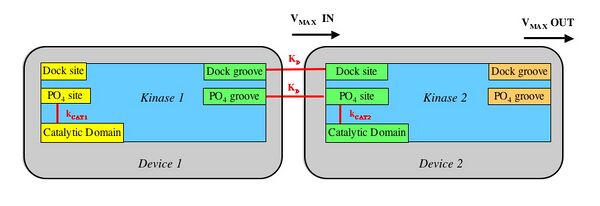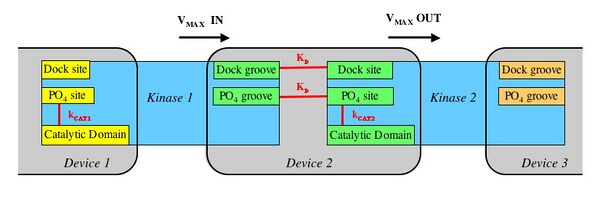Ssutton: PTL Logic
Discussion points from 1-23-06 meeting
Introduction
I am working to develop a new type of device, called Post-Translational Device, or PTD. PTD devices regulate the post-translational modifications of proteins to define system state and control cell function.
Current synthetic biological circuits make use of protein-DNA and RNA-RNA interactions to control gene expression in bacteria-- such circuits are examples of Transcription-based Logic. A brief comparison of the two types of logic is as follows:
Transcription-based Logic
- Engineered around gene expression
- Typical parts: transcriptional regulators, translational regulators
- Typical signal: PoPS, resulting in desired cellular concentrations of proteins.
- Easier to engineer than PTD
- Slow response time (hours)
- Uses one subset of cellular functions
PTD
- Engineered around protein modifications
- Typical parts: kinases, phosphorylation sites, docking sites
- Typical signal: rate of modification, resulting in desired state of proteins.
- More difficult to engineer than Transcription-based logic.
- Fast response time (seconds)
- Explores a new set of applications
In designing PTDd, I am working to answer the following questions:
- What is a PT part?
- What is a PT device?
- What signals are passed between devices?
- What are device performance specifications?
Below I will describe some of my ideas.
A Basic PTD System: Kinase-Kinase circuit
The most intuitive definition of a PTD is illustrated as follows.

- In this system, each device is essentially a MAP Kinase. Each device shown here contains the following parts:
- Kinase Scaffold
- Docking Site
- PO4 Site
- Docking Groove
- PO4 Groove
- Catalytic Domain
- The above parts are needed so that one MAP Kinase can recognize another. MAP Kinases recognize their substrates in two ways:
- The Docking Groove of the upstream kinase (e.g. Device1) binds to the Docking Site of the downstream kinase (e.g. Device2).
- The PO4 Groove of the upstream kinase binds to the PO4 Site of the downstream kinase.
- Once a MAP Kinase PO4 Site has been phosphorylated, the MAP Kinase undergoes a conformational change which positions the Catalytic Domain into its active conformation with catalytic activity parameter kcat.
- Devices can be linearly arranges so as to form a cascade:
- Device1 phosphorylates and activates Device2.
- Device2 phosphorylates and activates Device3, etc.
- The signal passed between devices is some sort of catalytic activity of one kinase for another.
The problem with the above system is that the output of one device can only be received by a device that contains compatible Docking and PO4 parts. The figure below illustrates points of part-part interactions, with red line connecting parts that must be compatibile.

This trans-part compatibility defeats the purpose of a universal signal carrier, and limits the utility and versatility of PTL devices. Note that we encountered the same problem when defining PDL devices and signals.
A solution is to re-draw the device boundaries such that all corresponding parts are within the same devices:

- In this system, each device contains the following parts:
- Two halves of a <font style="background-color: #